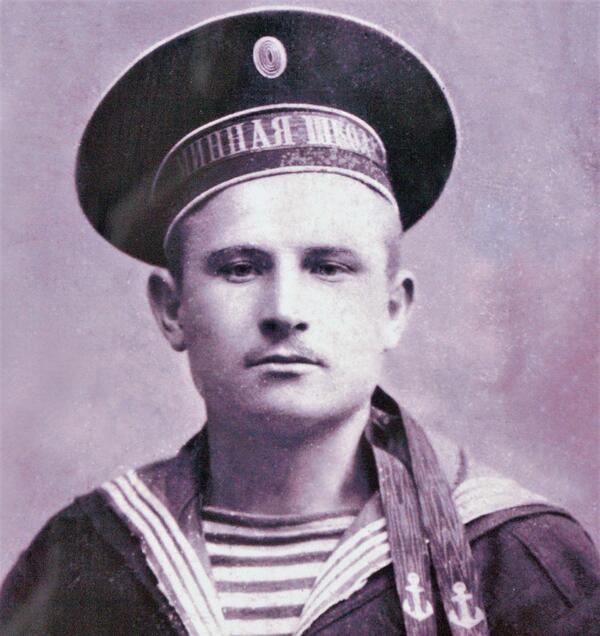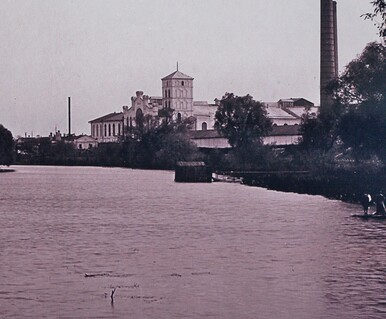The photograph from the museum collection depicts a resident of Shebekino — Grigory Goryainov, a participant of the Civil War and commander of a “red” partisan unit. The residents of Shebekino and Ustinka villages, who supported the Soviet regime, joined his unit. Their goal was to fight the Germans, as well as Ukrainian and White Guard units.
Grigory Goryainov was born and grew up in the village of Shebekino. During World War I, he served on the battleship “Eustathius” — the flagship of the Black Sea Fleet. Goryainov was a mine machinist, who serviced the torpedoes on the ship and was responsible for the proper functioning of the torpedo armament.
At the beginning of 1918, Goryainov together with a fellow sailor Sharapov returned to his native village. At that time the Shebekinsky volost, which was included into Ukraine, was occupied by German troops, who were Ukranian allies.
Grigory Goryainov became keen on communism ideas in the Navy: he was a member of the Sevastopol Bolshevik organization committee and led a unit of Black Sea sailors who fought against ataman Kaledin’s forces on the Don. In Shebekino, he led propaganda work among the workers at local enterprises, and then organized a unit of “red” partisans and became its commander.
In 1918, Grigory Goryainov came several times to negotiate with representatives of the soldiers' committee of the German garrison. They tried to negotiate that the Germans would not resist and would voluntarily surrender their weapons during the Red Army offensive. During one of these visits, Goryainov was mortally wounded — his killer remained unknown.
Grigory Goryainov was buried on the central square of the village of Shebekino. Some time later, his comrades-in-arms Grigory Kovalev, the sailor Sharapov and the 15-year-old Ivan Shevtsov were buried next to him. In 1949, an obelisk was erected on the site, on which their names are carved.
Shebekino units of “red” partisans became part of the 6th Korochansky Insurgent Regiment. In December 1918, its soldiers liberated Shebekino from German and Ukrainian forces, then Belgorod, and a month later occupied Kharkov, which was then the capital of Ukraine.
Grigory Goryainov was born and grew up in the village of Shebekino. During World War I, he served on the battleship “Eustathius” — the flagship of the Black Sea Fleet. Goryainov was a mine machinist, who serviced the torpedoes on the ship and was responsible for the proper functioning of the torpedo armament.
At the beginning of 1918, Goryainov together with a fellow sailor Sharapov returned to his native village. At that time the Shebekinsky volost, which was included into Ukraine, was occupied by German troops, who were Ukranian allies.
Grigory Goryainov became keen on communism ideas in the Navy: he was a member of the Sevastopol Bolshevik organization committee and led a unit of Black Sea sailors who fought against ataman Kaledin’s forces on the Don. In Shebekino, he led propaganda work among the workers at local enterprises, and then organized a unit of “red” partisans and became its commander.
In 1918, Grigory Goryainov came several times to negotiate with representatives of the soldiers' committee of the German garrison. They tried to negotiate that the Germans would not resist and would voluntarily surrender their weapons during the Red Army offensive. During one of these visits, Goryainov was mortally wounded — his killer remained unknown.
Grigory Goryainov was buried on the central square of the village of Shebekino. Some time later, his comrades-in-arms Grigory Kovalev, the sailor Sharapov and the 15-year-old Ivan Shevtsov were buried next to him. In 1949, an obelisk was erected on the site, on which their names are carved.
Shebekino units of “red” partisans became part of the 6th Korochansky Insurgent Regiment. In December 1918, its soldiers liberated Shebekino from German and Ukrainian forces, then Belgorod, and a month later occupied Kharkov, which was then the capital of Ukraine.



